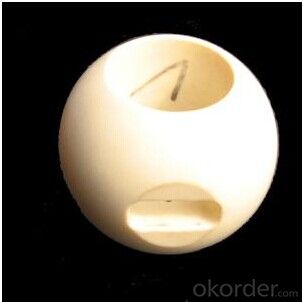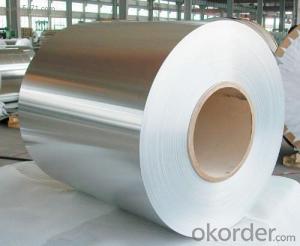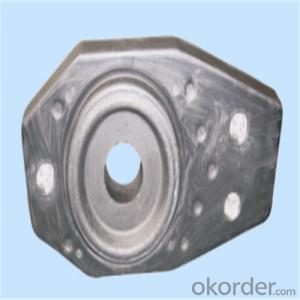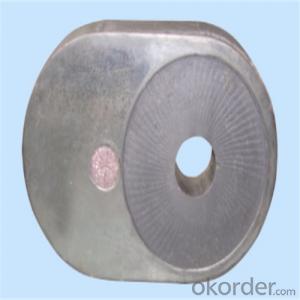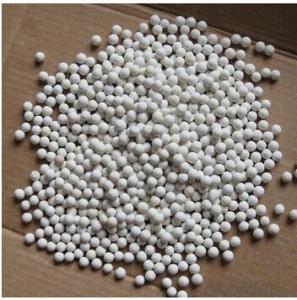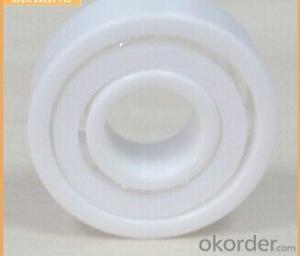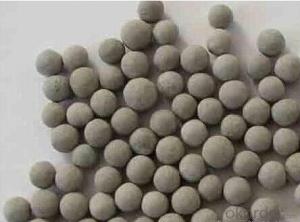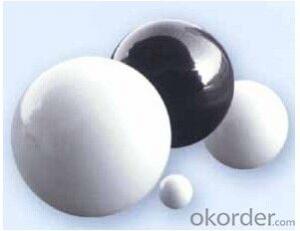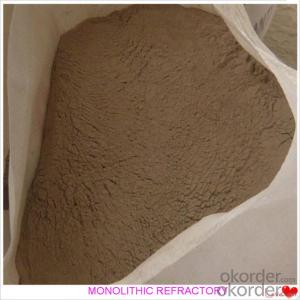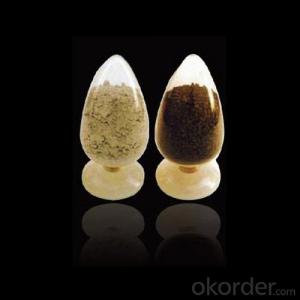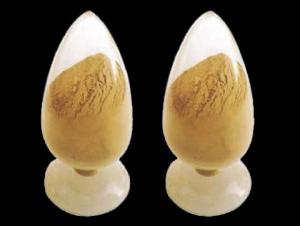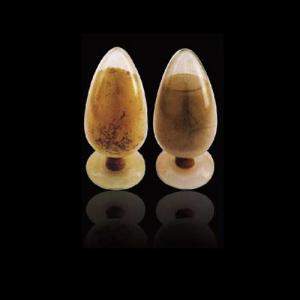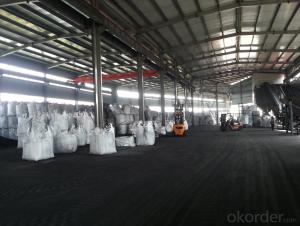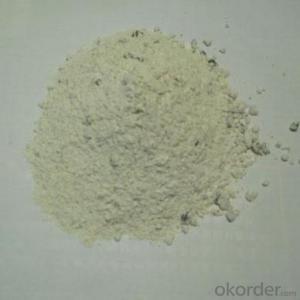Monolithic Refractories Ceramic Lined Ceramic Ball Valve for Iron and Steel Industry
- Loading Port:
- Qingdao
- Payment Terms:
- TT OR LC
- Min Order Qty:
- 1000 pc
- Supply Capability:
- 3000 pc/month
OKorder Service Pledge
OKorder Financial Service
You Might Also Like
Application:
Applied in any media, expect HF (Hydrofluoric Acid) or glass solution, with max. temperature up to 500°C or max pressure 5.0 Mpa, such as high corrosion, high attrition and middle pressure.
Structural: 3-part flange type float ball valve Flange standards follow DIN/ANSI/API/JIS
l Excellent wear-proof property of ceramic enables this valve have high reliability and prolonged lifespan which is 2-4times as much as Titannium Alloy and Monel Metal valve.
l Elastic O ring fit between metal part and ceramic part makes the whole part high sealing capacity, unables the two parts blind, and avoid the ball broken.
l Valve steams are selected among 316/316L stainless steel, HC alloy, Monel Alloy, structural ceramic.
l Completely symmetric design ensures dual leak-proof and two-direction usage to prolong its lifespan to twice.
All parts that connect the medium are made of structural ceramics with extremely high chemical stability and hardness (HRC 90), which is only inferior to diamond. So the valve features exceedingly high wear-proof capability, corrosion resisting, enduring capability, good heat insulation, small thermal expansion.
The valve is unique in granule medium of high hardness, or erosive soft granule and is the only choice for such medium. They are wisely used in FDG System, Slag system and LNCFS in power plant, saline water and distilling processes in alkali works, paper pulp system in paper mill, and so on.
The ball is processed by advanced polishing equipment and technology that can ensure high circularity, good surface quality,.
The self-lubricating capability of ZrO2, ensure the good sealing performance between the ball and its seat. It is thoroughly free from the defects of easy leakage, big torque, non-resistance sealing surface comparing with metal sealing valve.
ZrO2 Composition Chart of MZ Ceramic Ball Valve
NO. | Physical Property | Parameter |
1 | Crystal | >85% cubic, the rest monoclinic |
2 | Lg. Loss | 0.8%-1.0% |
3 | Average | 0.4-0.7um |
4 | Apparent Density | >0.4g/cc |
5 | ZrO2 Purity | >99.95% |
6 | Tapped Density | >0.8g/cc |
- Q: What are the quality control measures for monolithic refractories in the iron and steel industry?
- In the iron and steel industry, the quality control measures for monolithic refractories are essential to ensure the efficiency and safety of the production process. These measures involve various inspections and tests throughout the manufacturing and installation stages. Firstly, the raw materials used for monolithic refractories undergo rigorous testing. This includes analyzing the chemical composition, particle size distribution, and impurity content. These tests ensure that the ingredients meet the required specifications and are suitable for the intended application. During the production process, quality control measures focus on monitoring the mixing and blending of the materials. This ensures a homogeneous mixture and avoids any inconsistencies in the final product. The density and viscosity of the refractory castables or plastics are also checked to maintain the desired physical properties. Once the monolithic refractories are manufactured, they undergo several tests to evaluate their performance characteristics. These tests can include determining the cold crushing strength, modulus of rupture, and thermal conductivity. These properties are critical to ensure the refractories can withstand the extreme temperatures and mechanical stress present in the iron and steel industry. In addition to laboratory testing, quality control measures involve on-site inspections during installation. This includes verifying the correct application techniques, such as proper vibration, curing, and drying procedures. It is important to ensure that the monolithic refractories are applied correctly to achieve optimal performance and longevity. Furthermore, regular sampling and monitoring of the refractories' performance during operation are carried out. This allows for the detection of any signs of degradation or wear, enabling proactive maintenance and replacement before any significant issues arise. Overall, the quality control measures for monolithic refractories in the iron and steel industry involve comprehensive testing, monitoring, and inspection procedures. These measures aim to guarantee the reliability, durability, and efficiency of the refractories, ultimately contributing to the smooth operation of the iron and steel production processes.
- Q: How do monolithic refractories perform in ladle lining applications in the iron and steel industry?
- Monolithic refractories are highly effective in ladle lining applications in the iron and steel industry. Their outstanding thermal shock resistance, erosion resistance, and high refractoriness allow them to withstand the extreme conditions of molten metal and slag in ladles. Monolithic refractories also offer excellent thermal conductivity and low porosity, ensuring efficient heat transfer and preventing slag infiltration. Additionally, their easy installation and maintenance make them a preferred choice for ladle lining, ensuring prolonged service life and enhanced productivity in the iron and steel industry.
- Q: How are monolithic refractories recycled or disposed of at the end of their lifespan?
- Monolithic refractories, widely utilized in high-temperature industrial applications, offer various means of recycling or disposal once their lifespan concludes. The preferred approach depends on the specific monolithic refractory type and its composition. Reclamation stands as a common method for recycling monolithic refractories. This process entails collecting used refractory materials and subjecting them to processing to eliminate any impurities or contaminants. The resultant reclaimed refractory material can then be crushed, ground, or milled into a fine powder suitable for utilization as a raw material in manufacturing new refractories. Thermal treatment represents an alternative means of recycling monolithic refractories. This method involves exposing the used refractory material to high temperatures within a controlled environment, such as a kiln or furnace. The heat effectively breaks down the refractory material, eliminating any binders or impurities. The resulting material can then be reused as a raw material or integrated into other applications, such as construction aggregates. When recycling is not feasible, specialized facilities designed for handling and treating hazardous waste offer a disposal avenue for monolithic refractories. These facilities ensure the proper containment and treatment of the refractory material, minimizing any potential environmental impact. This disposal method is typically reserved for refractories containing hazardous substances or those that cannot be recycled due to their composition. It is important to emphasize that the appropriate disposal or recycling method for monolithic refractories must adhere to local regulations and guidelines. These regulations aim to ensure the safe handling, treatment, and disposal of these materials, taking into account their potential environmental and health effects. Therefore, industries and businesses must collaborate closely with waste management professionals and adhere to the appropriate procedures to responsibly manage monolithic refractories at the end of their lifespan.
- Q: What are the specific requirements of monolithic refractories for blast furnace applications?
- Monolithic refractories used in blast furnace applications have specific requirements to withstand the harsh conditions and high temperatures within the furnace. Some of these requirements include: 1. Thermal stability: Monolithic refractories need to have excellent thermal stability to withstand the extreme temperatures encountered in blast furnaces. They should resist thermal shock and maintain their physical and chemical properties at high temperatures. 2. High strength: Blast furnace conditions exert significant pressure and mechanical stress on refractory linings. Therefore, monolithic refractories need to have high strength and resistance to mechanical wear to withstand the weight of the burden and the movement of materials inside the furnace. 3. Chemical resistance: Blast furnace environments are highly corrosive due to the presence of molten metals, slag, and gases. Monolithic refractories should exhibit excellent chemical resistance to prevent chemical reactions with the molten material and gases, which can lead to refractory degradation. 4. Erosion and abrasion resistance: The materials being processed in a blast furnace can cause erosion and abrasion, leading to wear of the refractory lining. Monolithic refractories used in blast furnaces should be able to withstand these erosive and abrasive forces to ensure a longer service life. 5. Low porosity: Blast furnace refractories should have low porosity to minimize the penetration of molten materials and gases, which can cause refractory spalling and damage. Low porosity also helps in maintaining the thermal stability and overall performance of the refractory lining. 6. Dense structure: The refractory lining in a blast furnace should have a dense structure to prevent the penetration of molten slag and metal into the lining, which can cause refractory failure. A dense structure also aids in the refractory's heat insulation properties. 7. Easy installation: Blast furnace refractories need to be easily installed and repaired due to the frequent maintenance and repair requirements of blast furnaces. Monolithic refractories offer the advantage of easy installation, as they can be cast, gunned, or sprayed onto the refractory surface, allowing for quick repairs and reduced downtime. Overall, the specific requirements of monolithic refractories for blast furnace applications include thermal stability, high strength, chemical resistance, erosion and abrasion resistance, low porosity, dense structure, and easy installation. Meeting these requirements ensures the durability and efficiency of the refractory lining, leading to improved blast furnace performance.
- Q: How do monolithic refractories perform in rotary kiln applications?
- Monolithic refractories are highly effective in rotary kiln applications due to their unique properties and characteristics. These refractories are designed to be installed as a single, solid unit, as opposed to traditional brick and mortar refractories. One of the key advantages of monolithic refractories in rotary kilns is their ability to withstand high temperatures and thermal stresses. Rotary kilns operate at extremely high temperatures, often reaching up to 3000 degrees Fahrenheit. Monolithic refractories are able to handle these extreme temperatures without cracking or failing, ensuring the longevity and reliability of the kiln. Another important performance aspect of monolithic refractories in rotary kilns is their ability to resist chemical attack. Rotary kilns are commonly used in industries such as cement production, where the materials being processed can be highly corrosive. Monolithic refractories offer excellent resistance to chemical attack, protecting the kiln from deterioration and extending its service life. Additionally, monolithic refractories are known for their excellent thermal conductivity and insulation properties. This helps to maintain consistent and efficient heat transfer within the kiln, improving the overall energy efficiency of the process. Furthermore, the installation of monolithic refractories in rotary kilns is relatively easy and quick compared to traditional brick and mortar refractories. The monolithic materials can be cast or gunned into place, forming a seamless lining that eliminates the need for individual bricks and mortar joints. This not only saves time during installation but also minimizes the potential for weak points or gaps in the lining, ensuring a more durable and effective refractory system. In summary, monolithic refractories offer exceptional performance in rotary kiln applications. Their ability to withstand high temperatures, resist chemical attack, provide efficient heat transfer, and offer easy installation make them a preferred choice for industries relying on rotary kilns for their production processes.
- Q: What are the key properties of gunning mixes used for monolithic refractory repairs?
- Gunning mixes used for monolithic refractory repairs must possess several key properties. These include: 1. Exceptional durability: Gunning mixes should display outstanding resistance to thermal shock, abrasion, and chemical attack. This quality is crucial in ensuring that the repaired refractory material remains intact in the face of the harsh conditions prevalent in industrial furnaces and kilns. 2. High strength: Gunning mixes need to possess a significant compressive strength to provide structural integrity to the repaired refractory lining. This is particularly important in areas subjected to high mechanical stress or load. 3. User-friendly application: Gunning mixes should have favorable gunning properties, simplifying and streamlining the application process. They should be easily sprayed or gunned onto the surface requiring repair, resulting in a smooth and even coating. 4. Rapid setting and drying: Gunning mixes should boast a swift setting and drying time to minimize downtime during repairs. This ensures that the repaired refractory lining can be promptly reintroduced into service, reducing any potential production losses. 5. Excellent adhesion: Gunning mixes should demonstrate exceptional adhesion to the existing refractory material. This guarantees a strong bond between the new repair material and the old lining, preventing any potential delamination or separation. 6. Thermal stability: Gunning mixes should possess a high resistance to thermal cycling and temperature fluctuations. They should retain their structural integrity and mechanical properties even under extreme heat conditions. 7. Chemical compatibility: Gunning mixes should be chemically compatible with the materials they come into contact with, such as molten metals or corrosive gases. This ensures that the repaired refractory lining can withstand the corrosive effects of these substances. In summary, the essential properties of gunning mixes for monolithic refractory repairs revolve around providing durability, strength, easy application, rapid setting, good adhesion, thermal stability, and chemical compatibility. These properties guarantee that the repaired refractory lining can effectively endure the challenging operating conditions in industrial furnaces and kilns, thereby extending their lifespan and reducing maintenance costs.
- Q: How do monolithic refractories enhance the performance of ladle and tundish preheating systems?
- Monolithic refractories play a crucial role in enhancing the performance of ladle and tundish preheating systems in several ways. Firstly, monolithic refractories offer excellent thermal insulation properties, which help in retaining heat within the ladle and tundish preheating systems. This insulation capability minimizes heat loss, ensuring that the preheating systems operate at optimal temperatures. By maintaining a consistent and high heat level, monolithic refractories enable efficient preheating of ladles and tundishes, reducing the time required for the preheating process. Secondly, monolithic refractories have high refractoriness, meaning they can withstand extreme temperatures without undergoing any significant degradation. This feature is essential in ladle and tundish preheating systems, as they are subjected to intense heat during operation. The ability of monolithic refractories to withstand high temperatures ensures their longevity and prevents premature failure, leading to improved performance and reliability of the preheating systems. Furthermore, monolithic refractories have excellent resistance to thermal shock. Ladles and tundishes are often subjected to rapid temperature changes during the preheating process, which can cause thermal stress and result in cracking and spalling of the refractory lining. However, monolithic refractories, with their superior thermal shock resistance, can withstand these rapid temperature fluctuations without sustaining any significant damage. This resistance to thermal shock ensures the integrity of the refractory lining, prolonging the lifespan of the ladle and tundish preheating systems and enhancing their overall performance. Additionally, monolithic refractories offer good mechanical strength and abrasion resistance. Ladles and tundishes are frequently subjected to mechanical forces, such as stirring and pouring of molten metal. The presence of monolithic refractories with high mechanical strength and abrasion resistance ensures that the refractory lining remains intact even under such harsh conditions. This durability allows for prolonged and efficient operation of the preheating systems, contributing to their enhanced performance. In summary, monolithic refractories enhance the performance of ladle and tundish preheating systems by providing excellent thermal insulation, high refractoriness, resistance to thermal shock, and good mechanical strength and abrasion resistance. These properties enable efficient and reliable preheating, minimize heat loss, prevent premature failure, and prolong the lifespan of the preheating systems, ultimately improving their overall performance.
- Q: How do monolithic refractories resist chemical attack from molten metals and slags?
- A combination of factors enables monolithic refractories to withstand chemical attack from molten metals and slags. Firstly, these refractories are composed of high-quality materials with excellent chemical resistance properties, such as alumina, magnesia, or silica. These materials possess a stable chemical structure that can endure the corrosive nature of molten metals and slags. Secondly, additives or binders are often incorporated into monolithic refractories to enhance their resistance to chemical attack. By improving the refractory's capability to form a protective layer on its surface, these additives act as a barrier between the refractory material and the corrosive molten metal or slag. Furthermore, monolithic refractories are designed with a dense microstructure that restricts the infiltration of molten metals and slags. This dense structure minimizes the pathways through which corrosive agents can reach the refractory material, effectively reducing the risk of chemical attack. In addition, proper joint design and anchoring systems can be employed during the installation of monolithic refractories to prevent the infiltration of corrosive substances. This ensures that the refractory lining remains intact and capable of effectively resisting chemical attack. In summary, the combination of high-quality materials, additives, dense microstructure, and proper installation techniques contribute to the ability of monolithic refractories to resist chemical attack from molten metals and slags. This, in turn, extends their lifespan and maintains the integrity of the refractory lining in high-temperature applications.
- Q: What are some common maintenance practices for monolithic refractories in iron and steel furnaces?
- Some common maintenance practices for monolithic refractories in iron and steel furnaces include regular inspection and monitoring of the refractory lining for any signs of wear, damage, or erosion. This can be done through visual examinations, thermal imaging, or ultrasonic testing. Additionally, repairing and patching any damaged areas promptly is crucial to prevent further deterioration. Other practices include proper curing, preheating, and controlled cooling of the refractories to ensure their optimal performance and longevity. Regular cleaning to remove any slag, buildup, or debris is also important to reduce the risk of blockages or hotspots. Lastly, following manufacturer guidelines and recommendations for installation, usage, and maintenance is essential for effectively managing and prolonging the lifespan of monolithic refractories in iron and steel furnaces.
- Q: What are the advantages of using monolithic refractories in the iron and steel industry?
- Monolithic refractories offer several advantages in the iron and steel industry. Firstly, they provide excellent thermal insulation, helping to maintain high temperatures within the furnaces and kilns, ensuring efficient and consistent production processes. Secondly, monolithic refractories have high resistance to thermal shock and mechanical stress, making them durable and long-lasting in harsh operating conditions. Additionally, their ability to be easily shaped and installed reduces downtime during maintenance or repairs. Lastly, monolithic refractories have good chemical resistance, protecting against corrosive elements present in iron and steel production, thereby enhancing the overall performance and productivity of the industry.
Send your message to us
Monolithic Refractories Ceramic Lined Ceramic Ball Valve for Iron and Steel Industry
- Loading Port:
- Qingdao
- Payment Terms:
- TT OR LC
- Min Order Qty:
- 1000 pc
- Supply Capability:
- 3000 pc/month
OKorder Service Pledge
OKorder Financial Service
Similar products
Hot products
Hot Searches
Related keywords

